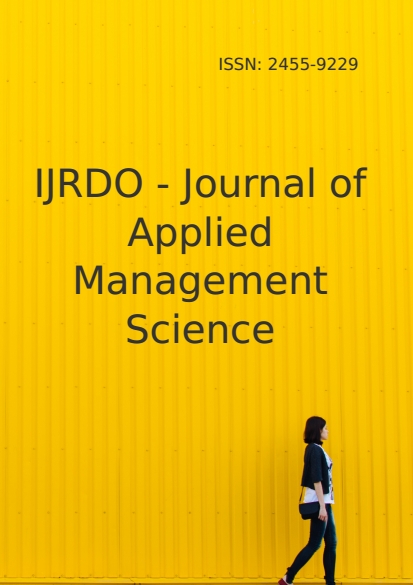ENGAGEMENT ORGANISATIONNEL DES EMPLOYES DES ENTREPRISES PUBLIQUES DE LA VILLE DE GOMA 2018-2019
Abstract
Le premier volet des résultats concerne le modèle tridimensionnel de l’engagement organisationnel développé par Meyer et Allen (1991), relatif à l’engagement affectif, normatif et de continuité (grand sacrifice et de manque d’alternatif). Notre préoccupation majeure était de savoir laquelle de ces dimension est la plus dominante chez les employés des entreprises publiques de la ville de Goma ?
Avec Comparaisons des types d’engagement par le test t de Student, nous avons remarqué que Les agents des entreprises publiques de Goma sont plus marqués par l’engagement affectif que par l’engagement normatif et l’engagement par manque d’alternatif (p<0,01). Les résultats montrent en outre que l’engagement grand sacrifice prédomine tout autre type d’engagement (p< 0,01). L’engagement affectif et l’engagement de continuité grand sacrifice sont les deux qui dominent chez les employés des entreprises publiques de Goma.
Downloads
References
Allen, N. J. et Meyer, J. P. (1990). « The measurement and antecedents of affective, continuance and normative commitment to the organization», Journal of Occupational Psychology, vol. 63, pp.1-18.
Buchanan II, B. (1974). «Building Organizational Commitment: The socialization of Managers in Work Organizations», Science Quarterly, vol.19, no 4, pp. 533-546.
Becker, T. E. (1992). «Foci and Bases of Commitment: Are They Distinctions Worth Making?», Academy of Management Journal, Briarcliff Manor, vol. 35, no 1, p. 232.
Cetin, M. O. (2006). «The Relationship Between Job Satisfaction, Occupational and Organizational Commitment of Academics. Journal of American Academy of Business, Cambridge, Hollywood, vol. 8, no 1, p. 78.
Camerman, J., Stinglhamber, F., & Vandenberghe, C. (2002). Justice et engagement affectif : un examen du rôle médiateur de la confiance. Psychologie du travail et des organisations, 8, 115-135.
Dienesch, R. M., Liden, R. C. (1986). «Leader-Member Exchange Model of Leadership: A Critique and Further Development», Academy of Management, The Academy of Management Review, Briarcliff Manor, vol. 11, no 3, p. 618.
Driver, M. (2002). «Learning and Leadership in Organizations: Toward Complementary Communities of Practice», Management Learning, 33(1), pp. 99-126.
Erdogan, B., Kraimer, M. L. et Liden, R. C. (2004). «Work Value Congruence and Intrinsic Career Success: The Compensatory Roles of Leader-member exchange and Perceived Organizational Support», Personnel Psychology, 57, 2, p. 305.
Fedor, D. B., Caldwell, S. et Herold, D. M. (2006). «The Effects of Organizational Changes on Employee Commitment: a Multilevel Investigation», Personnel Psychology. Durham, vol. 59, no 1, p. 1.
Graen, G., Seers, A. (1984). «The Dual Attachment Concept: A Longitudinal Investigation of the Combination of Task Characteristics and Leader-Member Exchange», Organizational Behavior and Human Performance, vol. 33, no 3; p. 283.
Hunt, S. D, Morgan, R. M. (1994). «Organizational commitment: One of many commitments or key me», Academy of Management Journal. Briarcliff Manor, vol. 37, no 6, p. 1568.
Hrebiniak, L., Alutto, J. (1972). «Personal and Role-Related Factors in The Development of Organizational Commitment», Administrative Science Quarterly. Ithaca, vol. 17, no 4, p. 555.
Kanter, R. M. (1968). «Commitmemnt and Social Organization: A Stady of Commitment Mechanisms in Utopian Communities», American Sociological Review, 33, pp.499-517.
Mowday,R. T., Poter, L. W., Steers, R. M. (1982). «Organizational Linkages: The Psychology of Commitment, Absenteeism, and Turnover», San Diego, CA, Academic Press
Poter, L. W., Steers, R. M., Mowday, R. T., Boulian, P. V. (1974). «Organizational Commitment, Job satisfaction and Turnover among psychiatric technicians», Journal of Applied Psychology, vol.59, no 5, pp. 603-609.
Truckenbrodt, Y. B. (2000). «An empirical assessment of the relationship between leader-member exchange and organizational commitment and organizational citizenship behavior. D.P.A.», Nova Southeastern University, AAT 998800, p.144.
Wiener, Y. (1982). «Commitment in Organizations: A Normative View», Academy of Management. The Academy of Management Review, Briarcliff Manor, vol. 7, no 3, p. 418.
Mayfield, J. et Mayfield, M. (2002). «Leader Communication Strategies Critical Paths to Improving Employee Commitment», American Business Review, vol.20, no 2, pp. 89-94.
Copyright (c) 2020 IJRDO - Journal of Applied Management Science (ISSN: 2455-9229)

This work is licensed under a Creative Commons Attribution-NonCommercial-NoDerivatives 4.0 International License.
Author(s) and co-author(s) jointly and severally represent and warrant that the Article is original with the author(s) and does not infringe any copyright or violate any other right of any third parties, and that the Article has not been published elsewhere. Author(s) agree to the terms that the IJRDO Journal will have the full right to remove the published article on any misconduct found in the published article.





